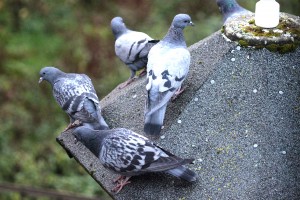 These days the first thing I do on walking through the garden is to listen to the bird song that seems to come from every part. The dominant ones are the blackbirds and, a more recent visitor, the mistle thrush. The background to these impressive and stimulating songs are the calls of the many smaller birds. The repetitive notes of the great tit, that the books says sound like “teacher-teacher”, and that rather pugnacious of birds, the robin, who songs vary with the time of the year. One of the reasons I pay particular note of the birds’ song and calls is that I am eagerly awaiting one particular bird.
These days the first thing I do on walking through the garden is to listen to the bird song that seems to come from every part. The dominant ones are the blackbirds and, a more recent visitor, the mistle thrush. The background to these impressive and stimulating songs are the calls of the many smaller birds. The repetitive notes of the great tit, that the books says sound like “teacher-teacher”, and that rather pugnacious of birds, the robin, who songs vary with the time of the year. One of the reasons I pay particular note of the birds’ song and calls is that I am eagerly awaiting one particular bird.
The bird is normally the first summer migrant to arrive in my garden – the willow warbler. It defies imagination as to the journey this tiny bird makes as it overwinters in Africa and part of the journeys there and back mean it has to cross the vast Sahara desert. No mean feat for a bird that weighs, on average, a few gms which is about the weight of a small coin. Then last week I heard a different range of call notes, a great deal of cooing. For a while I was confused as for the previous few weeks I had just been accepting the cooing of the wood pigeons. They seem to have been even commoner in the garden this year with numbers coming in for the mixed grain either on the bird table or on the ground. One or two more adventurous wood pigeons had even been visiting the mixed grain feeders hanging from the trees. However, that morning there were different cooing notes and I suddenly realised that not only were the wood pigeons calling but also collared doves and feral doves.
A few years ago the collared doves were common in our garden with several birds coming in all through the year. They are one of the most successful invaders from the continent, first breeding in England in 1955. The first pair known to have bred in the Highlands was in 1957 and I well remember the excitement from the birdwatchers. Their colonisation was, unlike that of the sea eagle and red kite, entirely by their own efforts and in the end they had colonised most parts, even some areas in the Western and Northern Isles.
The third bird cooing away in the garden was the feral dove and their origin is very intriguing. They originally came from the pure rock doves, some of which still breed in a few parts of the coast. These pure rock doves nest mainly along the coast with sea caves being their optimum choice. Many of these doves were captured and kept in doocots, some of which are still present in the Highland landscape. Good examples are the ones at Culloden, at Findhorn and at Gordonstoun School. They supplied food all the year round what with the adults, chicks and eggs but were only afforded by the wealthier people. With changes in agricultural practices many of the doocots fell into dis-use and the doves escaped and started breeding in the wild. These wild birds, or feral doves, were so successful there are now large flocks everywhere even in the middle of Inverness.
The success of these doves and pigeons is partly because they have the ability to breed in every month of the year. However their main breeding season is March to August but during that time they do manage to have three broods. They may only lay two eggs in each clutch, and pure white eggs that can be seen through their flimsy nest but they are they successful! As for the willow warblers I still await them with some anticipation.
Tags: highland wildlife
